Online Ferry Tickets
BODRUM-KOS FERRY & TURGUTREİS-KOS FERRY
Bodrum & Turgutreis - Kos Ferry Lines
Bodrum & Turgutreis - Kos Ferry Lines
We can offer attractive rates on the fast catamaran and car ferry services operating between Bodrum and Kos islands both for individual travelers and groups.
Meis İsland

Kastelorizo, current official name in Greek is Μεγίστη/Megisti; (Turkish: Meis , Italian: Castelrosso), is a small Greek island located in the Eastern Mediterranean. It lies roughly 1300 metres off the south coast of Turkey, about 110 km east of Rhodes, almost halfway between Rhodes and Antalya. It has gone by several different names in its history, including Castellorizo, Castelrosso, Meis.
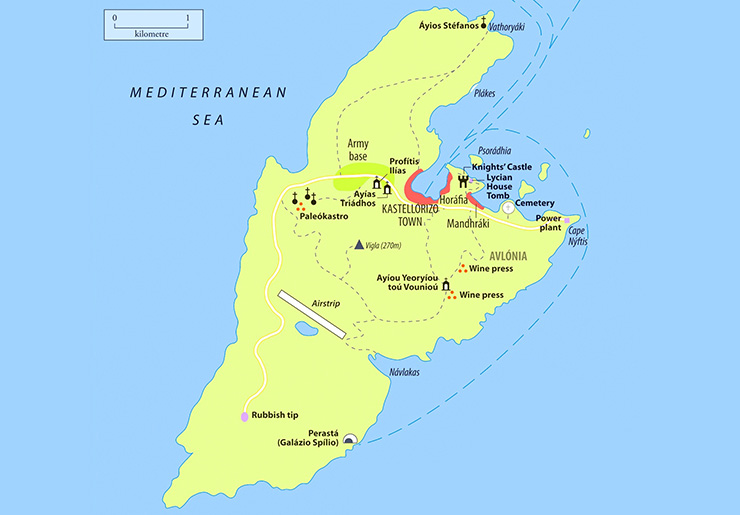
The meaning of its current official name Megisti (Μεγίστη) is "Biggest", a seemingly ironic choice since, at only 4 square miles (10 km²) in area, it is the smallest of the Dodecanese. The name, however, refers to the fact that it is the biggest of the small archipelago
Origin of the Name
There are several hypotheses about the origin of the name of the island. While there is a wide consensus that "Kastello" comes from the Italian word "Castello", meaning "Castle", the second part of the name could stem from the words:
"rosso" (Italian: "red"), either from the reddish colour of the rocks of the island (although they are rather greyish), or from the colour of the coat of arms of the Great Master of the Knights of Rhodes Hederia, which stands above the gate of the castle;
"rizon" (Greek: "root"), meaning "slope" of the mountain where the castle was built;
"horizon" (French). In this case the name would have been given by the Knights of Rhodes headed by Folques de Villaret who, conquering the island in the XIV century, were so impressed by the landscape as seen from the island, that they named the castle after it.
Geography
Satellite picture of KastelorizoKastelorizo is the easternmost Greek island and is situated in the Eastern Mediterranean. It lies about 2 miles (3 km) from the Anatolian coast (Lycia), more or less half-way between Rhodes and Antalya.
It is six kilometers long and three kilometers wide, with a surface of 9.2 km². It has a triangular shape, and is oriented from NE to SW. The island features three capes: Agios Stefanos (north), Nifti (east) and West (rather southwest); Between the first two there is a bay, with the only town in the island. Cape Agios Stefanos, the nearest to Anatolia, is 2250 m south of the Turkish town of Kaş (Greek: Andífli, the ancient Greek City of Antiphéllos).
Cape Nifti lies a little bit further away. The island is mountainous, with high and rough coasts, which become more difficult to access moving west. The soil is composed of limestone, and produces few olives, grapes and beans. On the island there is no source of potable water.
Description of the Island
Church of Agios NikolaosThe houses of the town are quite high and characterised by wooden balconies and windows of Eastern Aegean type. Behind the waterfront, many houses are ruined. At the beginning of the harbour, on the east side, stands the Delegation Building, erected in 1926 by the Italian architect Florestano Di Fausto, who designed the most important buildings of the Italian period in Rhodes too.
Then there is a mosque, not functioning any more, which has been now restored. From here starts the town's quay, which runs parallel to the eastern side of the harbour. The central square—Plateia Ethelondon Kastellórizou—lies halfway, near the yachting jetty.
Further away stands the Church of Agios Elías. Above the quay there is a pathway which leads to the Castle of the Knights of Rhodes. Of it remain the scarp curtain, part of a square tower, the remains of a cylindrical tower at the east corner, and toward the sea another cylindrical tower belonging to the oldest castle. A Doric inscription, carved in the rock, testifies the existence of a fortress during the classical age. Inside the tower there is a large covered cistern. The castle offers a beautiful view of the town and the Anatolian Coast, with the town of Kaş.
A small but interesting museum, placed over the mosque, informs about the history of the island. Its very heterogeneous collection includes diving suits, ceramics, frescoes, jewels, vases and coins. Beyond the museum, steps lead to the Lycian tomb, (the only one existing in Greece) carved in the limestone of the mountain, with a Doric Order facade carrying a Tympanum with Acroterion. The tomb is similar to those which are in Anatolia, but it is simpler. Ascending the steps on the eastern side of the town, one reaches the suburb of Horafia, where there is a square surrounded by the Church of Agios Georgios, with a high dome of Byzantine type, and the Cathedral of Agios Kostantinos and Heleni. It has three naves, divided by monolithic granite columns coming from the temple of Apollo Lykios in Patara (Anatolia). The columns carry ogival arches. Further east stands the small suburb of Mandraki, the commercial harbour.
West of the town, above the second highest hill of the island after Mount Vigla (270 m), stands Paleokástro (old castle) also named Panághia, after a Monastery of the Virgin. The Castle has Greek origin (see above, history section): its plan is rectangular and measures 60 x 80 m. In its interior stand an ancient tower, built with square limestone blocks, and large water cisterns. Carved on the base of the castle there is also a Doric inscription, dating back to the fourth or third century B.C., where it is summoned Megiste (the ancient name of Kastelorizo) and its dependence from Rhodes. On the east side there are remnants of Propylea. By far the main attraction of the island is the Blue Cave, on the SE side, named by the inhabitants phokialí (Greek for seal's refuge). Being 40-50 m long, 25-30 m wide, and 20-25 m high, it is much larger than the world famous Grotta Azzurra on Capri, Italy.
The light of the Sun, refracted through the first layers of sea water, is reflected in the interior of the Grotto, producing the well-known blue colour, and other effects, like the silvery appearance of submerged bodies. The Cave can be visited only by boat and, since the entrance is barely one meter high above the sea level, only under calm sea condition: the best time of the day to visit it, is early in the morning, when the Sun is still low.
Archipelago between Turkey and Kastelorizo
There are many islets in this area;Volos, near Kalkan (in Greek Kalamaki), Ochendra, Furmachia, Prassonisi, Rho, Tragonera, Marati, Strongili, Dhassia, Alimentaria, Kekova, besides many rocks and cliffs. The most important among these islets is Kekova (also named Caravola), not inhabited, which has an area of 4.5 km² and faces the Turkish village of Kaleköy (also named Simena). All these islets were subject to dispute between Italy and Turkey until 1932. According to Convention between Italy and Turkey, 1932, all islets - except Rho and Strongili -, attended to Turkey. (see below, History section).
History
Kastelorizo at dawnThe island was colonised by Dorian Greeks, who named it Megiste. Inscriptions found at the castle of Ai –Nikolas (paleokástro) confirm that during the Hellenistic period the island was ruled by Rhodes, being part of its Peraia. The Rhodians sent there an overseer. In the Byzantine Empire, Megiste-Kastelorizo was part of the 'Eparchy of the Islands', whose capital was Rhodes.
This province was essentially maritime. During the middle ages, Byzantines and Ottoman Turks disputed the island. In 1306 the island was taken over by the Knights of St. John Hospitaller of Jerusalem, headed by Folques de Villaret. They were on their way from Cyprus to Rhodes, which was conquered three years later, becoming the centre of their Crusader State. They restored the castle, which was thereafter used as prison for the unfaithful knights. In 1440 the island was occupied by Sultan Djemal-el-din of Egypt, who destroyed the castle.
Ten years later it was conquered by Alfons V of Aragon, king of Naples, who in 1461 rebuilt the castle and sent there a governor. Naples kept the possession up to 1512, when it was conquered by Ottoman Sultan Suleiman I. On September 22, 1659 during the war of Crete, the island was conquered by Venice—which destroyed the castle again— but the Ottomans were able to regain it after a while. Between 1828 and 1833 Kastelórizo joined the Greek insurgents, but after the end of the Greek War of Independence it came back in possession of the Ottoman Empire.
In 1912, during the Lybian war between Italy and the Ottoman Empire, the inhabitants asked general Ameglio, chief of the Italian occupation forces in Rhodes, to be annexed to Italy. Since this proposal was refused, on March 14, 1913 the population captured the Ottoman garrison and proclaimed a provisional government, until in August of the same year the Greek government sent from Samos an Overseer supported by gendarmes. These were expelled by the inhabitants on October 20, 1915. On December 28, 1915, a French expedition corps on board the cruiser 'Jeanne d'Arc' landed on the island. The French blocked another landing attempted in the same time by Greek Evzones. Turkish shore batteries responded to the French occupation by shelling the island, in 1917 succeeding in sinking HMS Ben-my-Chree. Due to the Treaty of Sèvres the island was assigned to Italy: the Italian navy took it from the French on March 1, 1921.
Kastelórizo—under the Italian name Castelrosso—was then integrated in the possession of the Isole Italiane dell'Egeo. The 1932 Convention between Italy and Turkey, which defined the sea border between the two powers, assigned all the islets of the small archipelago around Kastelorizo—except Rho and Strongili—to Turkey. During the 1930s it was a stopover for the french and italian planes, these ones flying from Rome to Beirut. During the Second World War, on February 25, 1941, British Commandos were able to occupy the island, but Italian forces coming from Rhodes reconquered it some days later. When Italy capitulated to the Allies (September 8, 1943), the island was occupied again in September by British commandos briefly, until the middle of 1944, when German forces took over. During the British departure, a fuel dump caught fire and spread to an adjacent ammo dump, whose detonation destroyed half of the homes on the island.
Kastelorizo was assigned to Greece with the Paris Peace Treaties, 1947. In May 1945 it was still under British administration, but only on September 15, 1947 effectively came under Greek administration. The island formally joined the Greek State on March 7, 1948 together with the other Dodecanese islands. The island has been more visited in recent years, by tourists looking for an isolated Dodecanese island, also thanks to the reference in the 1992 Best Foreign Language Film-Oscar winning movie "Mediterraneo" (1991) by Gabriele Salvatores. Kastelórizo was the only territory of the European Union where the Solar eclipse of 29 March 2006 was visible in its totality.
Demographics and Economy
The population—and the economy—reached its apogee at the end of the nineteenth century with estimated 15,000. At that time Kastelorizo was still the only safe harbour along the route between Makrí (today's Fethiye) and Beirut. Its sailing ships traded products from Anatolia (coal, timber, valonia, pine bark) against Egyptian goods (rice, sugar, coffee, tissues and yarns), and carried Anatolian cereals to Rhodes and Cyprus. On the island there was also a flourishing production of charcoal (much sought after in Alexandria, where it was used for narghile).
Fishing industry—mainly sponges—was important too. At the dawn of the twentieth century began the economy's decay, which was accelerated by the fall of the Ottoman domain and the deportation of the Anatolian Greeks in 1923. In the late 1920s the population of the island had dropped to 3,000, while about 8,000 inhabitants lived abroad, above all in Australia, Egypt, Greece and America. At that time the town had 730 inhabited houses, while 675 were already empty, and many ruined. The Population, according to 2001 census, has dwindled to 406, heavily subsidized so as to forestall territorial claims by Turkey (under the name of Meis Adası). Many of its emigrants went to Australia, where they are known as "Kassies", and especially to the cities of Perth and Sydney.
Traditions
Kastelorizo was famous for the traditions of its inhabitants. Beautiful, rich and magnificent was the women's dress, of at least three different types. It was made with brilliantly coloured fabric , and several necklaces, brooches, pendants and earrings made with ancient Venetian or Byzantines gold coins completed the dress.
The women's festive dress was made of: One or more long silky cloaks (ipokámiso). The most external one was closed on the front by six large filigreed gold or silver buttons.
These buttons was shaped as a half-sphere which was depressed in the middle. To the lowest one was hung a small chain with a cross; A pair of short pants (katofóri) whose lower part was made with good quality garment quilted with gold thread; A sleeved jacket (zepuni) made with brilliant coloured silk or velvet, opened at the front; Another long underskirt (kavadi), laced with gold thread , also opened at the front; A large scarf (zosma) made with three or four silk stripes, quilted with gold or silver thread.
It was tied very low on the sides, like a loose belt; A large velvet coat (gunna) decorated with gold and silver lace on the hems and on the back, with fur lapels: It was always kept open. A woollen cap; A quadrangular wrinkled silken shawl (mandili), decorated with relieved flowers and fringed hems, coloured in white, red and deep blue. Folded diagonally, it was fixed above the cap, with its longest angle fallen on the back almost to the ground, while the side edges were folded on the front or put above the shoulders. The socks were made with multicoloured wool or silk: the shoes were shaped like tipped slippers, and were made of velvet or silk.
They were laced with gold or silver thread and shorter than the foot. The other types of dress were similar, but not so garish and without fur decorations. The girl dress was simpler. Also different was the dress of single and engaged girls, and the one of married women and widowers.
Old Customs and Superstitions
The engagement, which was decided by the parents, and the wedding, which lasted 15 days, occurred through prescribed and curious ceremonies, having a symbolic and poetic meaning. The wedding was celebrated on Sunday, in the church of Agios Kostantinos, and an announcement on the main square invited the whole city to participate.
Also the baptism and the funeral (with the crying women (preficae) and the dish with oil and wine crushed on the coffin) had a well established ritual. On December 31 and on New Year, groups of children carrying small paperboard boats adorned with ribbons and small flags went around visiting houses, stores and coffee shops, singing good wishes songs and receiving coins and wheat cakes, while the old people exchanged visits. On the morning of Agios Basilios day, coming back from mass, the men customarily throw with force a pomegranate against the walls of their home, wishing for abundance and happiness for their family .
The more seeds spread around the rooms, the more luck the family would have in the coming year. During the feast of Agios Elias—on February 16—the men jumped in the sea several times, and wore the wet clothes the whole day. Those who did not want to participate, were forced to do so too. On Easter, the mass of Resurrection took place in the open, at midnight, the faithful bearing candles. As soon as the bells started ringing, the young people let off firecrackers, and the people said to each other the ritual words "Christ resurrected".
Then everyone entered the church and took from the hand of the priest the holy fire, then went home to light the fire in the fireplace. On Easter Monday the whole population gathered in the main square, and they remained there the whole day eating, drinking and singing. Single girls had to stay at home, but they were allowed to stay in the entrance, where they sang and played with swings. On May 1, at dawn, all the girls of the island, in groups, each one carrying a jar, went to get water out of town, but they were not allowed to speak a single word during the route.
This water (Amilito Neró, "water of silence") was supposed to bring good luck to the family. Everyone washed him/herself with it in that day, and every utensil and wall of the house was splashed with it. When a girl became engaged, she filled a crystal carafe with it and brought it to the future mother-in-law, who gave her in return a special cake and an odd number of gold coins.
When a child fell seriously ill, a sorceress was invited to her/his home. She drew cross signs on the body of the child with a thurible filled with embers and branches of olive tree which had been gathered in the church on Palm Sunday, pronouncing the following words: "Christ came: then he laid down his stick and chased away the snake and the bad neighbour from our home".
After this exorcism, the sorceress threw the content of the thurible in a bucket filled with water, and then counted the pieces of wood which did not burn. This number was said to be equal to the number of persons who were supposed to have enchanted the sick child. The enchantment of the child was sure, if the olive leaves burned with a loud crackling.
When a man was going to emigrate, gentle wishful songs were sung to him by his fellows.
Powered By DataNet Bilgi Teknolojileri









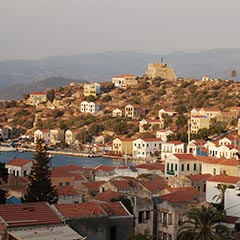
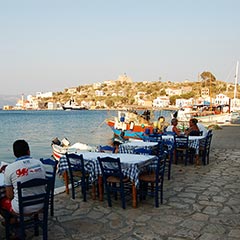
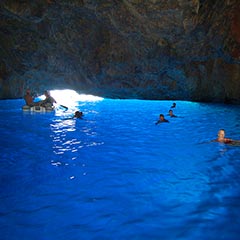
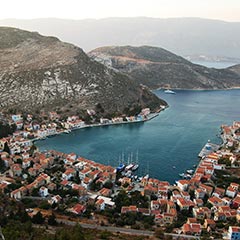
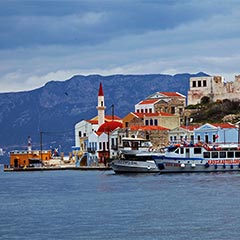
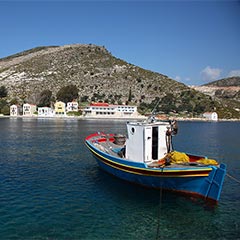
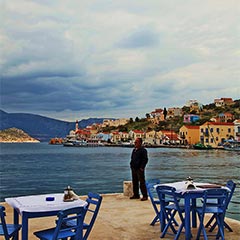
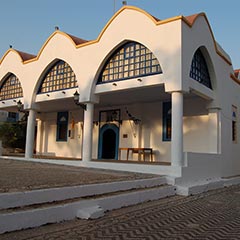
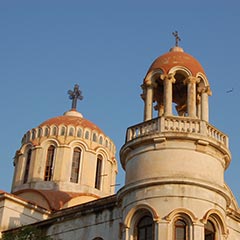
 Need a hotel? Visit TripAdvisor.
Need a hotel? Visit TripAdvisor. 



